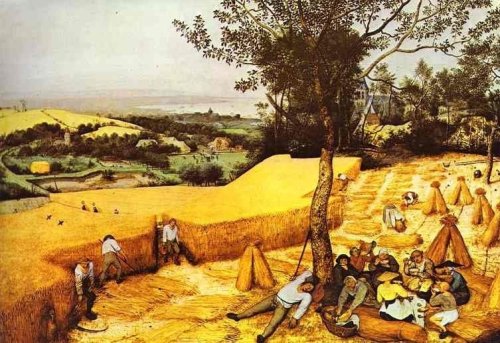Chapter 10. A 16th Century farm in 20th Century America
The farm my Grandfather bought in 1918 in Mountaindale New York was very similar to Pieter Bruegel's two farm paintings completed in 1565. Let me explain. When you look at art from an historical point of view, you find that these two paintings provide insight on what life was like on a 16th century Dutch farm. Before 1500 almost all art was either portraiture or was of a religious nature. The only function of landscape was as background for portraits. Around 1550 Pieter Bruegel started a new idea in Art. He was best known for his landscape paintings, Netherlands proverbs and realistic views of peasant life and folklore. In his painting "The Tower of Babel" he showed equipment, tools and building techniques of the 16th century. In his painting "The Peasant Wedding" he showed the food, clothing and structure of peasant life.
In 1565 he produced a series of paintings called "The Seasons." Among these was "Haymaking" and "The Corn Harvest." First let us take a look at the attached painting "The Corn Harvest." The scene depicted in this painting is similar to what you would find on the Perlin's farm in the 1930's. If an airplane were to fly over the farm in the 1930s, its passengers would see almost exactly the same scene that was depicted in the Breugel's work of 1565.
Before we discuss these paintings, let us look at the topography of the Perlin's farm. There were four levels. The first level was the road; the second level was the hotel, and behind the hotel on the second level were the barn and the lower level chicken coops. On the third level was a cow pasture; and on the fourth level was the hay field.
Bruegel's farm also had the hay field on top of the hill and the house and the barn on the lowest level next to the road.
On the days we had to go up on the fourth level we went up to the fields in the morning, did not come back to the house for lunch, and worked in the field until late in the afternoon.
Around noon someone would come up to the field with lunch and cold drinks to bring to the men. Three hay fields lay end to end on the top level, each about 300 feet wide. The fields were separated by two stonewall fences. The center field was about 800 feet long and the other two fields were about 500 feet long each, so the total length was about 1800 feet from end to end.
The middle field had several trees growing in the center, which would provide shade for eating lunch. Bruegel's painting also has trees in the middle of an open field where people are sitting in the shade having lunch. I don't know why there were trees in the center of his hay field, but I do know why there were trees in the center of our hay field.
One of the previous owners of the farm used to use these trees to pile stones against. These were stones that had been cleared from the field that winter. The frost in the winter would push the stones to the surface and every few stones had to be cleared and piled someplace.
Notice the wagon in the distance taking the harvest to the barn. Now turn to the hay making on the left side of the painting. You see men putting hay on a hay wagon. The pitchforks that they are using in Bruegel's 1565 painting are exactly the same as the ones we used 350 years later.
The man on top of the hay wagon was doing the same thing as my father did on our own hay wagon. Both of them use the same method of laying the hay in layers to balance the hay load. While I lived on the farm I never once saw any hay fall off the wagon on the way from the field to the barn. If you look closely, the harness was exactly the same. Even the hay rakes the women were carrying were similar to the ones we used.
If we had looked at the painting "The Tower of Babel" we would have seen the same tools that they had used 350 years earlier, the same hammers, screwdrivers, wedges. And the mechanical techniques were the same in 1565 as in 1918 when we bought the farm.
In regards to the farmhouse I could only imagine what it was like in 1918. There were no telephones, and commercial radio did not come into existence until 1922. There was no public electric service. My grandfather manufactured his own electricity by using a Delco plant. The well was under the house. There must have been indoor plumbing because the family had lived in a New York City apartment house for eight years. I can't imagine my grandfather going back to the way they had lived in Europe without electricity or indoor plumbing after having lived in New York City. It took him from 1918 to 1945 to pay off his mortgages, his bonds and all of his debt to bring his farmhouse into the 20th century. By 1945 he had reached his American dream: he owned lands, businesses, and at age 70 he was free and clear from all debt.

